DVD-Blu-Ray Availability: NONE
You may view this cartoon HERE.
One of Avery's finest works of cartoon art, this film has an egalitarian approach to animated humor. Everyone has the same chance to sink or swim, to shine or nosedive.
It is a shame that this important and delightful cartoon has not been restored. All available prints look washed-out and VHS-y. Many WB cartoons suffer from this (or other) neglect, and I hope work will be done to make them look at least something like they did in their heyday.
It's a tribute to Hamateur Night that its comedy transcends its current state of disrepair. The neglect may be due to this cartoon's public domain status. That said, several PD Warners cartoons were restored for the now-defunct Golden Collection DVD series.
We iris in on an obvious-but-funny sign gag. The lack of bad puns reassures us that "Bugs" Hardaway is far away.
The film's first bit of business is a charming status switch. Avery borrows this gag from myriad early talkie cartoons, but embellishes it with exquisite gestures.
Though the gag itself is ancient, the expressions of the bandmates-turned-conductors, with their eyes anticipating each move of the performer, as their hands attempt to guide him through this chaos, is priceless. This is a textbook example of Avery's gift to make the old new again.
A final three-trumpet fanfare...
and the conductor-turned-player takes a well-deserved bow.
The lights dim...
...and our sardonic emcee takes the stage.
Voiced by Phil Kramer *** (borrowed by radio-savvy Avery from the Joe Penner show, where he served as a stooge to the wanna-buy-a-ducker), the emcee is our blase guide to a stream of dubious amateur talent. This is a cartoon character with an unspoken backstory. He has hosted many nights of sub-standard performance. He has no power to affect the outcome of each act--that lies in the judge, who will be revealed, in a moment, then forgotten.
One pictures this emcee swigging from a pint of rye in-between acts.
Elmerhead can't wait to get on-stage.
He sings Avery's favorite hick signifier, "She'll Be Comin' 'Round the Mountain."
Avery's hand as artist is seen in the emcee's side profile. This Irv Spence-animated scene is an ideal blend of the director's scrappy visual style and a skilled artist/interpreter.
We never see who wields the hook...
Before emcee can get back on track, the train of thought is derailed by another Elmerhead serenade.
Two hooks are better than one...
Finally! "Next we have a talented artist--Maestro Paderwiski."
Music familiar to anyone who owns the Golden Collection DVD sets provides a fanfare, as the Avery Curtain© drops to the floor.The beauty of this gag is its excruciating set-up. The Maestro takes a small eternity to fuss with his mop of hair, fidget in his seat and demonstrate the pretentiously serious air of an Artiste. Unseen audience members shush one another, as if in reverent awe.
Maestro, who also reveals Avery's artistic hand in his profile,
smugly fishes a nickel from his tuxedo pants...
...and drops it in the slot of what we learn is a player piano.
The piano quakes with a honky-tonky version of "The Merry-Go-Round Broke Down."
This fraud remains smug...
We see the almighty Judge, in his only appearance,
as he decides Paderwiski gets the gong...
as he decides Paderwiski gets the gong...
...and the trap door (in a superior reprise of a routine from that early Avery
favorite, I Love To Singa.) Paderwiski goes down with dignity.
favorite, I Love To Singa.) Paderwiski goes down with dignity.
We hear the piano tinkle as it plummets downward into what must be an abyss.
The door in the floor seals itself. It's as if Paderwiski never existed.
As we digest what's happened, Avery cuts away to a patron gag...
Cartoon fact: Hippos in suits enjoy vaudeville.
Mel Blanc throttles his throat as he creates the patron's screams of agony...
Hippo is only now aware of the accident.
Poor dog has one of animation's funniest exit lines:
"Look at my feet! They're all crooked, an' everything..."
During this mishap, another contestant has taken the stage-- an escapee from
The Penguin Parade, who entreats us with some opera...
His fall from grace is swift and amusing. He had his chance
in this kangaroo court of a show; he lost; he plummets to the depths.
The abyss re-seals itself...
...and the curtain unfolds.
Another hippo, divinely voiced by our director, declares
the proceedings most ticklish. "It's a killer... heh heh heh...
It's a killer!"
The more straight-laced viewer in front of him is at first annoyed
by this broad outburst...
by this broad outburst...
...then rather amused at the fellow's gauche grunting.
He might consider a move to another row.
Too late! He's become a replica of "Mr. Nobody," the eerie opponent in
the Fleischer Brothers cartoon, Betty Boop for President (1933).
the Fleischer Brothers cartoon, Betty Boop for President (1933).
The party's over...
it's time to call it a day...
The sightline of the background's patrons doesn't match their
animated counterparts. Oh well...
animated counterparts. Oh well...
Damaged Patron #2 meekly departs.
Avery loves curtain gags, and this open-door effect is
clever and surprising. Our jaded emcee introduces...
clever and surprising. Our jaded emcee introduces...
"The Hindu mystic... Swa-mee Rivah. An' 'is besket."
The catchy "She's The Girlfriend of the Whirling Dervish," written by
Harry Warren, Al Dubin and Johnny Mercer, makes a familiar nod
to the Middle East, as River arches his eyebrows in an air of brooding self-importance.
River asks for a volunteer from the audience.
It's Elmerhead...
The contours and expressions in this sequence are gorgeously drawn. I'd say it was Robert McKimson's work--except, as Devon Baxter reminds me, McKimson was still with the Charles M. Jones unit at this time.
You know the drill...
The moist "pwut-pwut" sound effects add a grotesque edge to the routine.
Despite repeated finger snaps and verbal commands, the subject fails to appear.
River peers within the basket. By a subtle change of expression,
we understand the trick has gone horribly wrong.
we understand the trick has gone horribly wrong.
River tsk-tskes...
He calls for an usher.
"Give this gentleman his money back."
Swami resumes imposing pose as curtains close.
"An' now, da world's smallest entertainer..."
"Teeny Tiny Tinsy Tinny Tinny Tin."
The spotlight dwindles to match the wee form of this gifted flea.
Avery has done this gag before--an unctuously over-cute moppet stumbling on her recital--but he is now able to savage the sickeningly cute and have the audience on his side.
Her faltering rendition of "Mary Had a Little Lamb" earns her a long fall to doom.
Emcee's casual manicure actions bring an extra layer of comedy to a dismissal of an unliked character, in a manner the British comedy troupe Monty Python would embrace 30-ish years in the future.
Time for the next performer...
"Fleabag McPoodle anniz trained dawg ect!"
McPoodle, whose voice eerily anticipates Marvin Martian's, with its Richard Haydn- styled adenoidal plum, commands his dog to roll over...
play dead...sit...
and speak.
This is the moment this terrier has waited for. He clears his throat...
and uses the trope favored by windbags of his era, "Unaccustomed as I am to public speaking..."
He then, in fervent oration, lights into a speech:
"From the rockbound coast of Maine...
"to the sun-kissed shores of Califor-r-r-r-r-nyahhh..."
His passionate Mel Blanc-voiced declamation is cut fatally short.
Avery-voiced hippo is again tickled by the proceedings. Stalling underscores this scene with the haunting J. Fred Coots pop standard," You Go To My Head."
His seat-mates, also tickled, are inducted by hippo's roars of delight."It's a killer."
"Boy, that sure gets me."
We learn that this is a daylight show.
Next is a sequence designed to dispel the common wisdom that Avery did not develop great comedic timing until his M-G-M days. This is a breakthrough film for Avery, both in terms of comedy and pacing. His aim is true here, and the accuracy of each tomato-assault is breath-taking...
Thespian wolf (an embryo of the Shakespeare-spouting hound of the 1947 cartoon A Ham in a Role) attempts to emote Hamlet's "to be or not to be" soliloquy (from the picture of the same name). Well-aimed tomatoes pre-empt his success.
After his second pelting, the wolf gets wise to the routine, and tries to anticipate the messy missile. He almost succeeds:
Tomato patiently waits in mid-air."THAT is the qu--"
Splat! And fare thee well...
Nice perspective on this curtain-fall.
Continuing in a Bard mood, our emcee attempts to introduce the next act...
"Da belcony seen from Romeo an' Juliet-TAH."
Spoit!
That wholly unexpected tomato is cream of Avery. Its appearance, and the emcee's lack of reaction to its impact, are solid gold.
Mel Blanc and Sara Berner enact this theatrical trope with utter sincerity-- which makes it all the funnier. Their scene is underscored with the tune so hated by Owl Jolson--"Drink To Me Only With Thine Eyes," from the 1936 favorite I Love To Singa.
Amidst this (so far) straight enactment of R & J, Avery inserts one symbolic jape. The crescent moon melts to butter in reaction to the couple's steamy kiss.
Berner sneaks in a "rally, I do" -- a pet Avery-ism to deflate Hollywood pomp-- into the words of the Bard of Avon.
Off-screen hippo bellows in amusement to this s'posta-be-serious scene.Actors are rightly vexed.
Hippo lets it go on far too long.
They attempt to return to character...
But those high-impact hyuk hyuks return.
Romeo gets tough.
We hear an off-screen gunshot.
Romeo returns, having slain the sole opposition to his thespian art.
"...Let me thrill again to the soft, sweet tones of your voice..."
In a moment of comedic-horrific brilliance, the hippo's guffaw has
been transferred to the Juliet actress.
Romeo's s___ is freaked.
Curtain closes...
And another gunshot rings out!
In this innovative sequence are motifs we'll see in two M-G-M Averys-- Half-Pint Pygmy (1948) and Bad Luck Blackie (1949). It can't be stressed enough that many of the brilliant moments of Avery's 1940s cartoons--his finest work--were born in his Merrie Melodies of this period.
The past minute of this cartoon has been sustained genius. That balcony scene can't be topped, so our emcee wraps up the proceedings.
Another clever curtain bit."An' now, folks..."
Elmerhead, who has recovered from multiple stab wounds, returns to "soy bomb" our humble host.
Nice touch: top hook catches Elmerhead's derby.
Again, emcee's profile is pure Avery cartooning.
"An' now, folks..."
"let's see who wins da cup."
Operatic penguin?
Nope.
Swami River?
Nix. Trained dog?
Nope.
Shakespeare Wolf?
No go.
Romeo?
No--and, in a lovely small touch, the actor is stunned at the ignorance of his audience. How dare they?
Annoying interloper?
Yes!
Deadpan emcee does a series of highly effective Avery takes-- the best examples to date in his filmography, and all the more effective for the character's lack of charm and engagement.
Emcee has to look at Elmerhead to make sure he isn't hallucinating.He is not.
The cartoon's finale is a crowd-scene cycle that must've taken its animator all day to perfect. An entire audience of Elmerheads! This is a logic leap, given that we've seen many shots of the anthromorphic-animal audience. Perhaps they all cleared out in disgust.
Iris out on Tex Avery's first true masterpiece.
Everything in Hamateur Night works. Each comedic and narrative choice is made with authority and conviction. The promise Avery's prior work has shown (and it has been enormous) finally flowers. This is as perfect a film as Avery could make, at this stage in his career.
As noted earlier, its democratic approach is the key. No one is the clear hero or villain in this cartoon. Everyone has equal stakes. The emcee has no real authority. Any faith we have in him as the protagonist is destroyed with one well-aimed tomato.
Every participant in Hamateur Night has the power to affect the cartoon's outcome. No one action or reaction is bigger--or better--than another. In a genre of comedy founded on status--every chase cartoon made in Hollywood is about its rise and fall--this cartoon has no such concerns.
It's inevitable that this film is one-of-a-kind in Avery's filmography. Only his final theatrical cartoon, Sh-h-h-h-h-h (1955), comes close to this ground zero, in that its "villains" are impartial and thus immune to prosecution. Another Avery masterpiece, 1949's Bad Luck Blackie, shifts traits of the antagonist to the protagonist (as seen in the balcony scene here), but its roles of good and bad guys are clearly and inextricably set.
Though some of the animation design is still hit-or-miss, as only a 1939 theatrical cartoon could be, the quality and vigor of the animation is high. Part of this picture's success is the consistency and fluidity of the animation. Setting up the populist vibe of this cartoon is one thing--but making it live and flow is another, greater task. It's a credit to Avery's animators that they bring a lot of what's right about Hamateur Night.
Another Avery masterwork--Thugs With Dirty Mugs--is around the corner. We'll bide our time patiently as we examine Avery's next effort...
And that's A Day At The Zoo.
***--thanks to Keith Scott for his invaluable information on who-voiced-what. The voice artists are responsible for so much of a cartoon's success, and their lack of credits in the released films makes animators' seem copious in comparison.
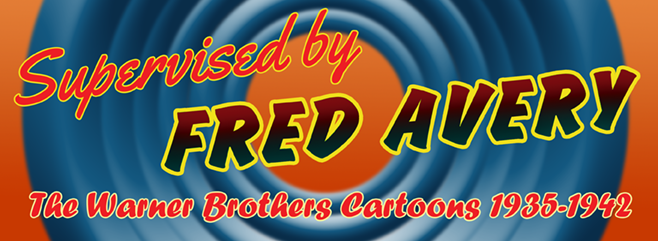







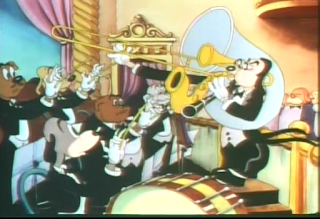













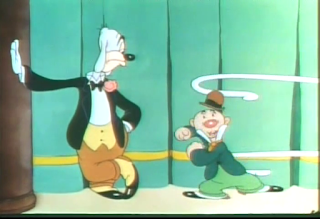








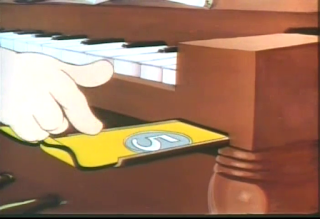

























































































































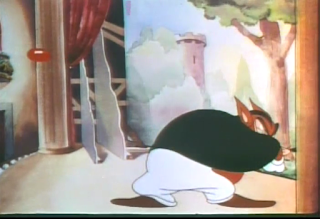
























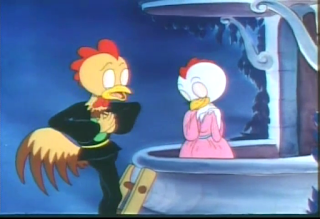































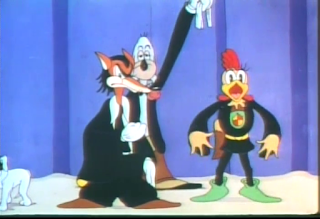










In a period where Tex would lean more and more on the spot gag cartoon to fill out his Merrie Melodie releases, this in a way if the ultimate spot gag effort, in that several of the bits could be switched around and still have the same effect (though the R&J gag has to be the final act, since it doesn't work unless we've experienced Tex's hippo laugh throughout the cartoon).
ReplyDeleteBut where it differs from the other lesser spot gag efforts is in the unification of all the pieces into the talent show narrative, where all are in a single location competing for the same prize, climaxed by the payoff for the running gag with Elmerhead (and this could be the only cartoon where you have not just one but two running gags, both of which produce payoffs that fit Avery's credo of "What would the audience least expect?"). There's a funny, cynical sophistication here that had rarely been seen before and would be part of the best of the 1940s cartoons, from Avery, Warners and elsewhere.
When I was little, my parents bought a VHS set of public domain cartoons. This was one of my favorites, but since the title cards had been lopped off, I had no idea who made it for the longest time. Now I can definitely tell it's an Avery cartoon.
ReplyDeleteThank you for this blog-a couple of these shorts were in that set, and your blog has really brought back memories for me.